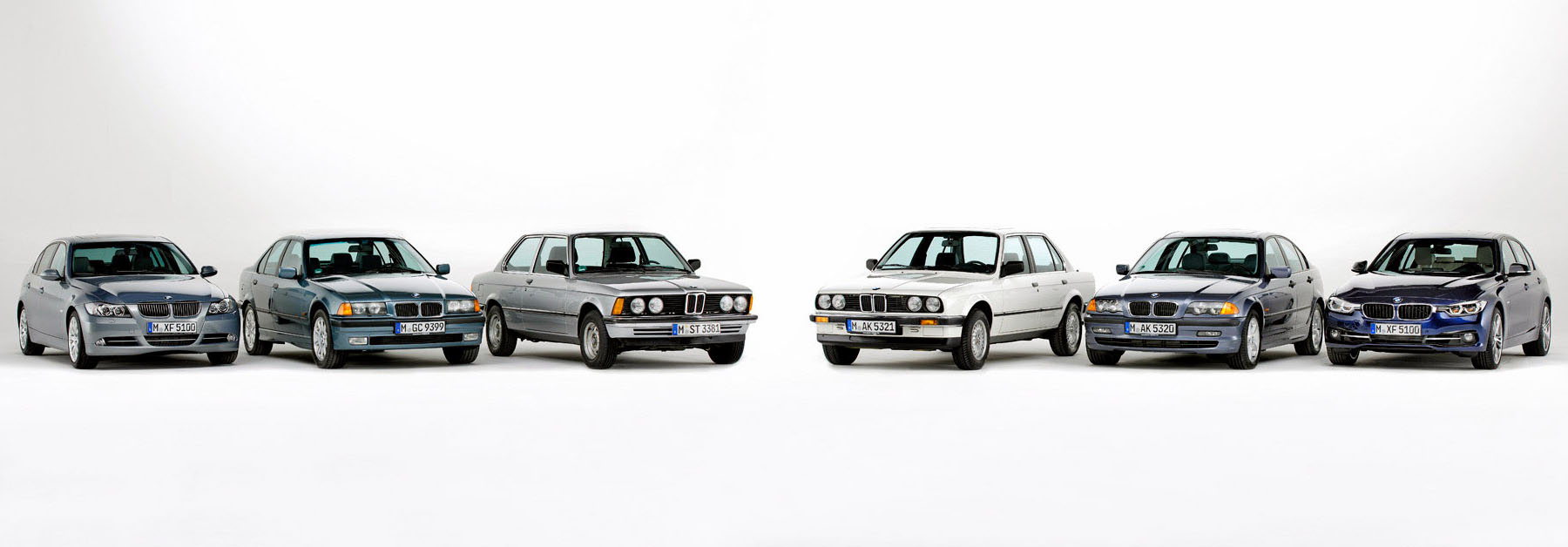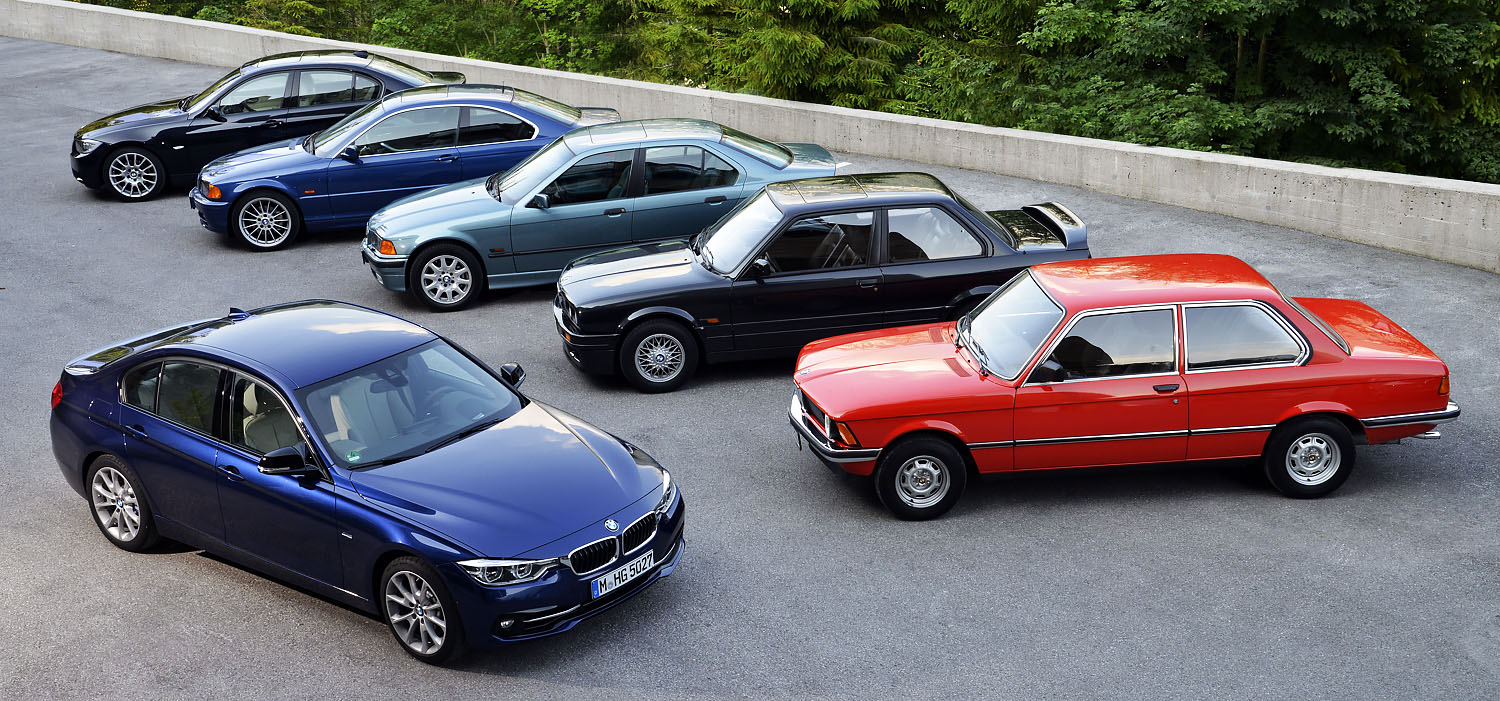
Looking back at four decades of BMW’S biggest success. Hard to believe that the BMW 3 Series is 40 years old. It’s also hard to imagine a time when the phrase “3 Series” meant nothing. To actually exist in such an era, you’d need to go back to 1974 in your hastily constructed time machine and enjoy watching Nixon squirm through impeachment in the wake of Watergate.
That’s how enduring the 3 Series is. Before it came along, BMW didn’t have any sort of coherent naming policy for its models, short of the “E-codes” that identified their development within the factory. But in the wake of the E12 5 Series, a pattern was being set that has remained to this day. You only have to look at how, over the four decades since, the phrase 3 Series has become shorthand for “highquality compact executive car” to understand the importance of this nameplate. That’s the sort of brand power that rivals would kill for.
BMW obviously recognizes the celebrity of the car that not only transformed its model badging, but also its fortunes. It held a special event at its “Vierzylinder” Munich headquarters in May in Germany to celebrate the occasion by announcing the latest updates to the current, sixth-generation car and to preview a 40th anniversary display of the 3 Series story in the museum. What a car to celebrate. More than 14 million Threes have been sold globally since 1975, with one in four current BMWs leaving worldwide showrooms being either a 3 Series Sedan or Wagon. It first appeared in 1975, the E21 first-generation designed initially by Paul Bracq and latterly Claus Luthe, with Wilhelm Hofmeister penning a design flourish that remains on most BMWs to this day: his fabled, eponymous 39 forward-running “kink” at the base of the C-pillar. It also featured the double kidney grille, although quad headlamps — another BMW signature — were reserved for higher-spec models, but inside the driver-angled dashboard made a debut.
Today, the originator remains strangely overlooked and unloved compared to some other Threes, this despite the fact that it doubled BMW’s annual sales shortly after going on sale. Maybe it’s because it was born as a result of the 1974 fuel crisis, with an emphasis on economy. Maybe it’s the largely carbureted range of engines, whereas other Threes are predominantly fuel injected. Maybe it’s because there was just a choice of two- or four-door sedans, plus the Baur Cabriolet, giving a limited choice when it came to models. Most likely it’s because there was never an M Division version, although the E21’s performance credentials were bolstered by road-going Hartge and Alpina specials, while the incredible Group 5 racing version found success on the track. Perhaps a key part of the Three’s longlasting appeal is that it has always been imperious on racetracks around the globe, and none more so than the E30 M3. This remains the most successful touring car of all time, winning more races than any other tin-top. It was based on the secondgen, E30 3 Series, launched in 1982 and styled by Luthe. More body styles — the Touring and a proper, flat-shouldered Convertible — were introduced, while diesel power and four-wheel drive also made debuts. But it was the arrival of the M3, for model year 1986, that really transformed the 3 Series from niche luxury to object of desire. This wide-arched, high-revving, track-derived, four-cylinder performance legend kindled a public love affair with the letter M that hasn’t abated to this day. Indeed, total E30 production in the 11 years it was built surpassed 2.3 million units; it’s fair to say this is the Three that rocketed BMW into the big time.
Which meant the poor old E36 third gen, arguably still the clearest step up over its immediate predecessor in the Three’s history, is left in a not-quiteclassic, not-quite-modern black hole when viewed in retrospect. It was hugely advanced compared to the E30, not the least through the addition of the Z-axle multi-link rear suspension; the E30 simply had semi-trailing arms. There was a hatchback model, too, in the form of the Compact, built on E30 underpinnings. Even the M3, which made 317 hp in its ultimate 3.2 Evo incarnation — a long way ahead of the most powerful E30 M3, the 235hp Sport Evo — wasn’t as loved as its forebear, because it was a much more refined and grown-up sort of car. The rawness had gone. But while critical acclaim might now pass the E36 by, at the time it didn’t and sales eclipsed even those of the E30.
The E46 had a great platform to build on when it was introduced in 1998 (again, late E36 production slightly overlapped into 1999). In many ways, the fourth-gen Three was a very similar car to the E36, with the gently evolved styling courtesy of Designworks USA — including a certain Mr. Chris Bangle. And it used software for the in-car entertainment and information that was designed to be updateable; hence, E46s can run advanced, 21st-century systems that keep it feeling modern. Once again, sales surpassed the already-successful predecessor, but that might have had something to do with the birth of a true classic: the E46 M3. This returned the compact sports coupé to the pinnacle of road car dynamics, never more so than in awesome CSL form, probably the high watermark of all Threes.
Of course, we didn’t get the CSL in the States — just the M3 Competition Package that cherry-picked some of the CSL’s goodness — and there were briefly issues with oil starvation on the M3’s S54 engine over here, too. But nonetheless, the third M3 was something very special.
By the fully fledged “Bangle Era,” the E-codes for the fifth-gen Three had split, so E90 was the Saloon, E91 the Touring, E92 the Coupé, and E93 the Convertible, which now featured a folding metal roof. Around 2.1 million of these four body styles were sold worldwide from 2004 to 2012, with the M3 reaching its apogee in normally aspirated form with the development of a 4.0L V-8 making 414 hp; this evolved into the strictly limited, 4.4L, 444hp M3 GTS in April 2010. The E90-gen Three was also the first to use run-flat tires, which is either a good thing or a bad thing, depending on how much you value ride quality. This 3 Series then handed the baton on to the current F-coded sixth-generation cars in 2012, with the life-cycle impulse (LCI) the latest announcement in the 3 Series lineage.
“Three’s history is left in a not-quite-classic, not-quite-modern black hole when viewed in retrospect. It was hugely advanced compared to the E30, not the least through the addition of the Z-axle multi-link rear suspension; the E30 simply had semi-trailing arms.”

So where is the 3 Series heading, into its 41st year and beyond? Well, three-cylinder gasoline engines are first up, the 1.5L as seen in the Mini and as part of the BMW i8’s innovative drivetrain being pressed into service in a new 318i. Meanwhile, at the business end of the range, the 335i is no more, replaced by a 322hp TwinPower Turbo engine that’s said to be all new, with the badge on the back now reading 340i. Visual changes for the F3x LCI models are minor — the light clusters front and rear have been revised, while the interior gets some chrome trim to spruce things up. Well, as they say, if it ain’t broke… And next year we’ll get the 330e, a plug-in gas-electric hybrid with 250 hp, 0-60 mph in 6.1 seconds, 67 mpg, and CO2 emissions of just 49g/km. The high-tech future has arrived in the 3 Series body. From carburetors and Baur open-tops, to the Gran Turismo, hybrids, all-wheel drive, and three cylinders, the 3 Series story is far from finished. Another 40 years of the Three? Don’t bet against it.
“From carburetors and Baur open-tops, to the Gran Turismo, hybrids, allwheel drive, and three cylinders, the 3 Series story is far from finished.”
1975 BMW E21 3 Series makes its debut at Munich’s Olympic Stadium in July.
1977 Six-cylinder engines, codenamed BMW M20, arrived in the Three for the first time.
1982 Second-gen BMW E30 arrives.
1983 E21 production ends.
1985 BMW E30 M3 arrives, based on 1986MY cars.
1987 E30 receives major update, Touring model introduced.
1991 BMW E36 hits the European market. E30 Touring and Convertible continue.
1993 All E30 production ends.
1998 BMW E46 model introduced, final E36s finish production a year later.
2001 BMW E46 M3, with 338hp 3.2L inline-six, launched.
2003 M3 evolves into awesome CSL; we don’t get it in the States, sadly…
2004 BMW E90 fifth-generation car revealed.
2007 V8-powered M3 arrives. It proves to be the last normally aspirated M3 to be built.
2010 Incredible M3 GTS DTM refugee launched as limited edition.
2012 Current “F3x” generation 3 Series goes on sale.
2015 The LCI is announced, with three-cylinder models and a plug-in hybrid due next year.
Road test all generations of 3-Series BMW





